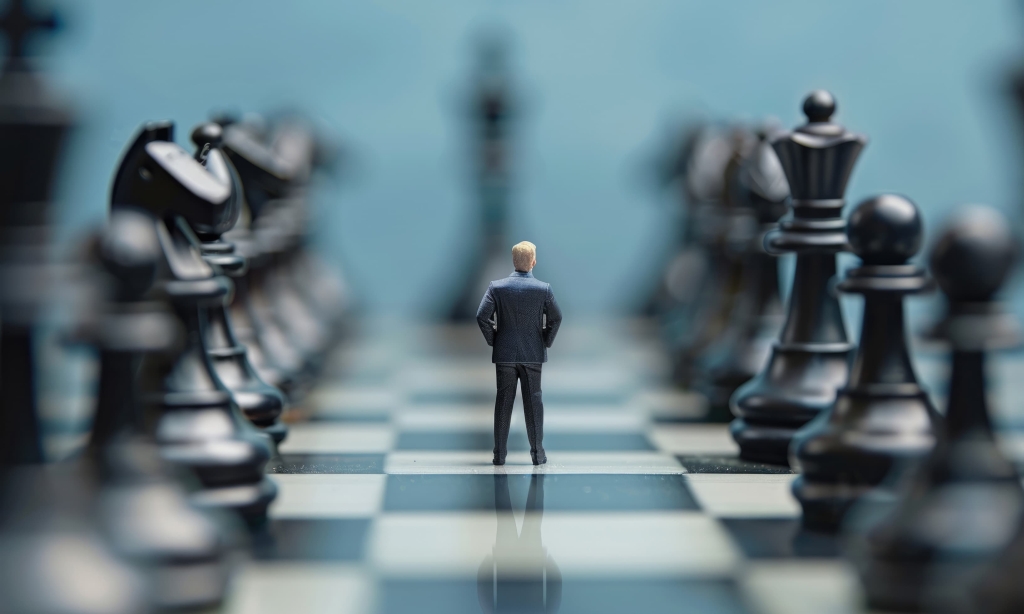

 Article
Article

 From billion-dollar business deals to split-second survival choices, we make countless decisions daily. But which mental system should we trust: our lightning-fast instincts or our methodical logic? UVA Darden's Saša Zorc discusses how understanding both can lead to better choices in business and life.
From billion-dollar business deals to split-second survival choices, we make countless decisions daily. But which mental system should we trust: our lightning-fast instincts or our methodical logic? UVA Darden's Saša Zorc discusses how understanding both can lead to better choices in business and life.

Insights from
Written by
When you make decisions, do you take time to methodically gather data and make the most rational and calculated choice possible? Or do you rely on your intuition and “go with your gut”?
It’s probably both. And it probably depends.
“We like to think of ourselves as a sole entity, but we’re really working with two systems internally, and they compete for which gets to make decisions in our brain,” says UVA Darden assistant professor Saša Zorc. “They each have advantages and disadvantages.”
The intuitive side of human decision-making, what psychologists call System 1, is driven by emotions and memory, while System 2 is the rational, logical, mathematical part of your brain.
In our data-driven world, we might think the latter is the “right” choice. But they both have value.
“The intuitive side of things is not dismissible as random junk; it’s the pinnacle of millennia of evolution, and it’s part of how humans are smart,” says Zorc, a PhD in Decision Sciences.
Our brains replace complex problems with simple approximations that work remarkably well – these mental shortcuts, or heuristics, are often quite effective, he says.
Of course, humans evolved in an environment that is very different from the one we have today.
When our ancestors were confronted with an urgent choice, say, what to do when threatened by a tiger, the autonomous nervous system would fire off a response. The limbic system automatically makes muscles stronger, reflexes faster and peripheral blood flow higher — but it does this by redirecting resources away from the brain, which puts rational decision-making at a disadvantage.
“So, while this is great if you have to flee or fight, it’s really bad when it happens in, say, a job interview,” Zorc notes. “And it regularly happens in an interview because this is a situation in which many people naturally feel a sense of fear or stress. In many contemporary contexts, this is where our intuitive responses systematically mess up.”
“Game theory has become, arguably, the central theory of economics,” says Zorc.
That’s because it’s a very flexible mathematical theory. ”It concerns any situation in which there are multiple decision-makers and the consequences for any one of them depend not only on their own decisions, but also on those of the others,” he adds
Game theory applies to traditional, tangible, strategic games like chess or poker, but it’s much bigger than that: Market competition between companies falls into this framework, too, so it’s become a dominant discipline in economic theory. Numerous Nobel prizes have been awarded for research on the subject, and in organizations, it’s a key aspect of strategy and negotiations. It has also become a central tool in military strategy, particularly as it concerns nuclear deterrence.
Foundationally, it starts with the Nash equilibrium: a set of strategies, one for each player, with a property that no player has the incentive to do anything different. Theory guarantees that virtually all systems contain such a point and shows that many systems will naturally converge to these stable situations, which is why it’s been instrumental in the design of markets.
In essence, when everyone acts in their own interest, the system reaches equilibrium, says Zorc, adding: “Markets work well if people compete against each other and they’re in equilibrium, and they don’t work well if, for example, multiple companies collude to fix the price. That’s why we have anti-trust laws.”
In some ways, he adds, “It’s like magic. Even a manager who doesn’t have a full grasp of economic theory will adjust the quantity of a product and its price point based on what the competition is doing. If such a sequence of managers trying to ‘one-up’ one another converges, it will converge to the equilibrium. It is a marvelous prediction.”
And it applies to individuals, too. At some point in their careers, virtually every employee will face situations in which they’re competing with other decision-makers.
But people are unpredictable and emotional, and in some situations, they will systematically deviate from these predictions because of the psychological ways they make decisions.

To illustrate the human factor that comes into play in negotiations, Zorc explains “the ultimatum game.”
Consider two players. The first is given $100 and must propose a split of that amount between them . The latter player can accept what Player 1 offers or not — in which case no one gets anything.
“Game theory suggests that the optimum for Player 1 to suggest is a 99-1 split, and Player 2 can accept the deal and get $1 or reject the deal and get nothing,” Zorc says. Logically, it makes sense for Player 2 to accept; $1 is more than $0.
“But people are not like this. So, if I offer you $1 out of $100, you may think I’m being unfair, and you may care more about spiting me for being horrible than you do about getting a dollar. Who cares about a dollar?”
There are similar situations that play out in the working world. “Workers are willing to put up with some things from their superiors, allowing those superiors to extract value out of them,” says Zorc. “But people are not generally willing to put up with all the value to be extracted out of them — even if they can’t do anything about it. They would rather burn bridges than put up with it. This aspect of behavioral psychology is the spite bias.”
Interestingly, the amount employees are willing to put up with likely depends on social hierarchy: “If you’re dealing with the president of the United States, you’re probably willing to put up with a lot and allow a good deal of your value to be extracted, and you’ll concede to a great deal. But if someone you perceive as a peer asks for as much, you probably won’t be willing to put up with a lot,” Zorc says.
When people are willing to take personal losses in order to punish someone they perceive as being unfair, it is bad for the individual, but it’s actually very good for society, because it enforces pro-social behavior, adds Zorc. “It ensures bad behavior is punished.”
The winner’s curse is a phenomenon that happens when a bidder overestimates the value of an asset, therefore paying a higher cost and making the “win” amount to an actual loss.
“This is very real,” says Zorc. “It is fundamentally a problem of information asymmetry, as the buyer is unaware of the true value of the purchase.”
For example, a company may put out a request for proposal to construct a new building, and multiple construction companies will send proposals that include estimates for how much it will cost to build the structure. Typically, the company willing to fulfill the project’s requirements at the lowest price will be the one that is awarded the contract. But because the winning company has likely underestimated the price, they may overall lose money on the building.
To adjust for this, when bidding, the companies need to bid more than they think it will cost — and how much more depends on the number of competitors. When the competition is more intense, the winner’s curse is more significant. If they normally mark up a project by 10–15 percent, if it’s a big and competitive project, they may need to mark it up by 20 percent.
Not infrequently in sports, a first-year player who is best in the league will then see a second season with disappointing results.
“This is not a curse and not a coincidence,” says Zorc. “It’s a matter of statistics.”
In any activity in which the result depends on both skill and luck, it stands to reason that the person who performs best in the first round is likely the beneficiary of a lot of luck as well as skill.
When they reach the following year, they’ve got another draw of luck, and though their talent may not have diminished, it’s statistically unlikely that they’ll be as lucky in the following year. It’s not necessarily that they’ve psyched themselves out.
“My motivation for this realm of study is the marriage of two parts of my experience: I worked in mathematics, which has such powerful tools, but they’re mostly deployed to solve abstract problems,” Zorc explains. “I wanted to have more impact on the real world, so I worked in consulting, which was the polar opposite: There were these big, important problems, but not enough time to solve them in a serious way. So why don’t we use the powerful tools to solve problems in a more meaningful way?”
Professor Saša Zorc teaches alongside Professor Manel Baucells in the Darden Executive Education & Lifelong Learning program Decision Making Strategies That Get Results, which focuses on making strategic business decisions through powerful frameworks from behavioral economics and game theory.
A member of the Quantitative Analysis faculty, Zorc studies incentives in multi-agent systems, such as health care and decentralized matching markets, using search and contract theories, mechanism design and data-driven simulations.
He received his Ph.D. in decision sciences from INSEAD in Singapore, where he taught courses on probability, statistics, decision theory, econometrics, health care economics and microeconomics.
B.Sc., M.Sc., University of Zagreb; MBA, Cotrugli Business School Zagreb; M.Sc., Ph.D., INSEAD
Game Theory Meets Gut Instinct: Smarter Choices in Business and Beyond
Share